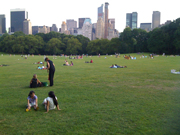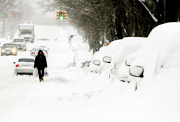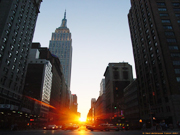There is no bad time to travel to New York. Whether sizzling or drizzling, the city's charmer potential is as stable as a mountain. However, be aware that its weather is almost as unique as everything else in the Big Apple. If you are unprepared for it, it might hamper your enjoyment.
So don’t resort to letting a smile your umbrella. Don’t walk on the sunny side of the street. Just take a look at this weather guide and decide what type of climate is more fitting for your travels around the city.
If the nickname "Asphalt Jungle", bestowed upon New York City by pop culture halfway through the 20th century, feels so adequate for the Big Apple it's because it's true in more ways than one. The city's humid subtropical climate is one the least thing travelers expect from seeing photos and videos of New York.

So if you are thinking of traveling to New York City in the summer, brace yourself for a very particular brand of hot -- even if the temperatures usually stay at an otherwise reasonable 90º Fahrenheit (32º Celsius).

And don't forget that the city that never sleeps is an island, and therefore sensitive to the urban heat island effect -- that is, the heat will be absorbed during the day and will be radiated back at night, throwing an extra 7º Fahrenheit (4º Celsius) to every night winds are slow.
On the other hand, if you are thinking of traveling during the winter, be reminded that 25 to 35 inches of snow are tolerable by New Yorkers' standards. Locals have grown to develop a relationship with the snow, and can walk through it as if it wasn't there. Unless your home country has similar weather conditions, it's best not to imitate them.
Also, don't neglect to appreciate the mesmerizing effect of the ubiquitous snow flakes, especially when looking out the window towards the New York skyscraper-laden skyline.
| Month | Minimum Average Temperature (Celsius / Fahrenheit) | Maximum Average Temperature (Celsius / Fahrenheit) | Average Sunlight (hours) | Wet Days (+0.25 mm) |
| January | -4 / 25 | 3 / 38 | 5 | 12 |
| February | -4 / 25 | 4 / 40 | 6 | 10 |
| March | 1 / 34 | 7 / 44 | 7 | 12 |
| April | 6 / 43 | 14 / 57 | 7 | 11 |
| May | 12 / 53 | 20 / 68 | 8 | 11 |
| June | 18 / 64 | 26 / 78 | 10 | 10 |
| July | 19 / 66 | 29 / 84 | 10 | 12 |
| August | 19 / 66 | 29 / 84 | 9 | 10 |
| September | 16 / 61 | 26 / 79 | 8 | 9 |
| October | 9 / 48 | 21 / 70 | 7 | 9 |
| November | 5 / 41 | 11 / 52 | 6 | 9 |
| December | -1 / 30 | 5 / 41 | 5 | 10 |

Every day in New York is special, but some days are more special than others. Four days in particular.
It all started in February 1807, when the Manhattan City Council turned to the state Government to lend them a hand in deciding how to lay out the streets that were being constructed non-stop in the city. The state Government in turn made a three-member commission to create a solution.
Four years later they had it: an eight-foot map with 12 main north-south avenues and numerous cross streets, with Broadway running at an angle through it. It's the now-famous grid plan, defining New York City as a series of blocks equally distributed. (It's also the reason why streets in New York don't have names an numbers -- saying something is in 4th Street with 5th Avenue gives you all geographical coordinates you need.)
Flash forward to 2002, when astrophysicist Neil deGrasse Tyson, of American Museum of Natural History fame, had a truly inspired epiphany. He realized that, given Manhattan's symmetrical structure, at some point during the summer and winter the sun fully illuminates every single cross street during the last or first fifteen minutes of daylight.
If the Commissioners had actually made the grid to match the geographic North-South line, those special days would be equinoxes. But since Manhattan is rotated 30 degrees east from geographic north, these four special days are May 28, July 12 for sunset and December 5 and January 8 for sunrise.
The phenomenon is called Manhattanhenge (as a reference to the Stonehenge, the English monument at which the sun aligns with the stones on the solstices), although unlike it, it hasn't yet been attached to any esoteric significance. Dr DeGrasse Tyson isn't optimistic, though. "Upon studying American culture and what it is important to it," he was quoted at saying, "future anthropologists might take the Manhattan alignments to be cosmic signs of Memorial Day and, of course, baseball's All-Star break."
While that day arrives, the day is a keystone in many photobloggers' calendars.